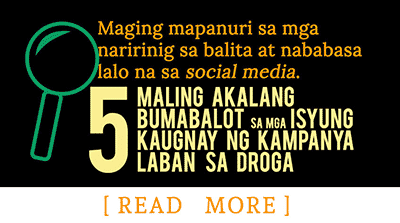Last December 3, 11:00 PM, the Philippine Atmospheric, Geophysical and Astronomical Services Administration (PAG-ASA) issued the first weather bulletin regarding Super Typhoon ‘Hagupit’. With its local name ‘Ruby’, its initial strength was pegged at maximum sustained winds of 160 kilometers per hour (kph) near the center and gustiness of up to 195 kph. It was forecasted that it will be at east southeast of Guiuan, Eastern Samar on evening of December 5 and in Borongan, Eastern Samar by evening of December 6.
The typhoon may not be as strong as Yolanda but because it is slow-moving and brings heavy rainfall, strong winds and storm surges.
Five landfalls are likewise being projected to happen. It made its first landfall at 9:15 PM of December 6 in Dolores, Eastern Samar, its second landfall by morning of December 7 over Cataingan, Masbate and the third landfall in Torrijos, Marinduque.
By afternoon of December 8, the Philippine Red Cross released a report around 3:42 PM that at least 21 people are reported dead in Visayas, many of them drowned as flood waters rose in Borongan, the capital of Eastern Samar. The breakdown of casualties is as follows: one from Western Samar, one from Northern Samar, three from Iloilo, and 16 from Eastern Samar, specifically from Borongan.
The government had evacuated more than a million people as the powerful typhoon approached the country from the Pacific Ocean, fearing a repeat of a Super Typhoon Yolanda last year that left more than 7,000 dead or missing.
Although it has been downgraded to a tropical storm it has continued to lash the Philippines with locally heavy rainfall. As the typhoon transverses Marinduque, it raised fears from the residents because this might caused the collapsed of the abandoned mine dams of the former Marcopper Mining Corporation. This issue was also raised by the provincial disaster coordinator of Marinduque. The Provincial Disaster Risk Reduction and Management Council (PDRRMC) have already evacuated 1,500 residents in low-lying areas, particularly along riverbanks and coastlines, since December 6. Most of the residents have voluntarily evacuated. Once the dam breaks, it would cause catastrophic flooding to the towns of Mogpog and Boac.
The National Disaster Risk Reduction and Management Council (NDRRMC) issued the following figures in relation to Typhoon Ruby. General data confirmed, as of this writing, that:
A total of 232,948 families (1,074,080 persons) are affected and a total of 230,569 families (1,066,141 persons) are currently being served inside and outside evacuations centers.
Two deaths are reported in Iloilo – Thea Rojo, 1, and Ernesto Baylon, 65 – due to hypothermia.
Two provinces have declared state of calamity – Albay and Camarines Sur.
In general, the affected areas did their homework and prepared for the worst. They have learned from their experiences from Yolanda. The community needed no convincing – they know when it is needed to evacuate and they know what to do.
The government, on its end, also did their part. In a report released by the Department of Social Welfare and Development (DSWD), relief goods have been flown in advance to the Eastern Visayas where local government units are expected to take care of repacking them. This is supposed to ensure faster distribution. The military have prepositioned troops and assets in Eastern Visayas and placed on standby those in nearby provinces so they could immediately assist Eastern Visayas if necessary.
Casualties are minimal but it can be projected that there is huge damage to properties, infrastructure and livelihood.
NETWORK SITUATION
Project Pagbangon (Eastern Samar)
As early as December 3, the people as well as the local government units of Guiuan, Homonhon and Manicani are already preparing for the typhoon. The convents and parishes, even the Bishop’s Palace, instantly became evacuation sites for the communities. Some people from the communities made the field (rice) their evacuation sites and made an effort to secure their safety. The idea of having a better, suitable evacuation site is one of the areas that need to be explored by the LGUs and other concern agencies, organization or institutions.
The need to secure food and other necessity became a priority for the people of the area, becuase the stores are closed down and have their goods gone early due to panic buying. PMPI partners, particularly SIKAT and MAG local organizers, got in touch with the LGUs regarding the possibility of collaborative effort regarding the aftermath of Typhoon Ruby.
As the typhoon brought forth its strong winds and drastic downpour, the community maintained their contact via SMS but during power outage and telecommunication shut down that the information exchange stopped. Initially, the following figures were gathered from Guiuan, Eastern Samar:
Number of evacuation centers: 8
Number of evacuees: 5,120 (excluding those in private buildings)
Number of relief packs distributed: 5,120 (as of December 5) with additional 3,083 (as of December 6)
SIKAT and MAG coordinators and organizers are already getting in touch with LGU in Guiuan and looking at the possibility of pooling resources to help the affected communities.
In the rapid field appraisal (RFA) in Homonhon conducted by PMPI local staff Jesil Hombria, she found that there is no reported casualty and the immediate needs of the community are food and medicines. There are 10 houses that are severely damaged but nobody is hurt.
In Manicani, according to local staff Emiliana Balbada, there is no reported casualty and what the community needs are food and aquatab to ensure the safety of drinking water. In Barangay Hamorawon, she reported that the fishpens are destroyed.
It is evident that the somehow the community and the LGUs have prepared for the disaster. People in the community went to evacuation centers – schools, church and health centers early enough. Some even created foxhole-type of evacuation areas. LGUs tried to identify evacuation areas and worked on stockpiling. Reports from our local facilitators said that LGUs distributed relief packs to some barangays prior the typhoon and, then, in all barangays after the typhoon.
Cluster Situations
Negros, Panay and Southern Tagalog reported strong winds and heavy rains while CABUSTAM said that there was a forced evacuation already being conducted in the area and boat trips to Siargao and Dinagat are halted. As of the moment, there is no casualty reported and only minor damages have been brought by the typhoon.
As this afternoon, Southern Tagalog cluster is on an alert mode. The situation of some partners based from the text that the Secretariat received seemed crucial. People from Marinduque was made to forced evacuate. Another partner said that the national roads between Torrijos and Sta. Cruz are already unpassable due to rock fall. They also expressed possibility of conducting relief operations when needed but would decide only after the landfall in their area.
The Central Visayas cluster, where some Yolanda affected communities were also hit said they are alright for now and help can be channelled to other regions that would need it most.
In Bicol, Socal Action Center of Legazpi requested that we focus the help in Rapu-Rapu, one of PMPI Sites of Struggle (SOS) for Anti-Mining Campaign. The Secretariat is able to contact our partner people’s organization in Rapu-Rapu. They reported that there is no casualty and major damages. They are thankful for the concern and said that they are alright and do not need much help.
SAC Borongan of the Eastern Visayas cluster communicated on December 3 that they are preparing for the worst and they are coordinating with the local governments. Relief goods and evacuation centers are being readied by both LGUs and the Diocese. Fr. Odick Calumpiano intimated that if help will be needed from Misereor and PMPI they would propose to focus on the northern part of Eastern Samar which is among the least served most of the time. A satellite phone is available in the diocese, just in case regular communication will not work anymore. Also, Ian Mosquiza sent an SMS to the Secretariat saying that Borongan, San Julian, Taft, Can-avid, Dolores, Oras, San Policarpo and Arteche are heavily affected. He also stated that there is an estimated 23 deaths (a data released by Red Cross). Relief items like food, water, medicines for diarrhea, colds and fever, candles, etc. are desperately needed.
The Peace and Conflict Journalism Network (PECOJON), days before the landfall, have established a platform for regular updating on Typhoon Ruby’s movement and continuously been giving out information and reports regarding the effects of the typhoon from their local media members.
The Secretariat
The Secretariat issued the following advisories prior to Typhoon Ruby’s landfall:
Disaster Advisory 01 contains updates about the typhoon and a request to the cluster if they can coordinate with the Secretariat the situations in their respective areas.
Disaster Advisory 02 contains the exact location of the typhoon.
Disaster Advisory 03 contains the information about areas with public storm signal warnings.
Disaster Advisory 04 contains the area where the typhoon will make landfall.
Also, the Secretariat had a meeting to plan the response on Typhoon Ruby/Hagupit. In the course of the typhoon (and up until this moment), the Secretariat issued situational reports via SMS to partners in Bicol and Southern Tagalog clusters. It established a system of communication between the people in the community to the local CO/CF and to the Secretariat. Regular updating is being done via texts and Skype to track the impact of Ruby and map out possible response of PMPI.

